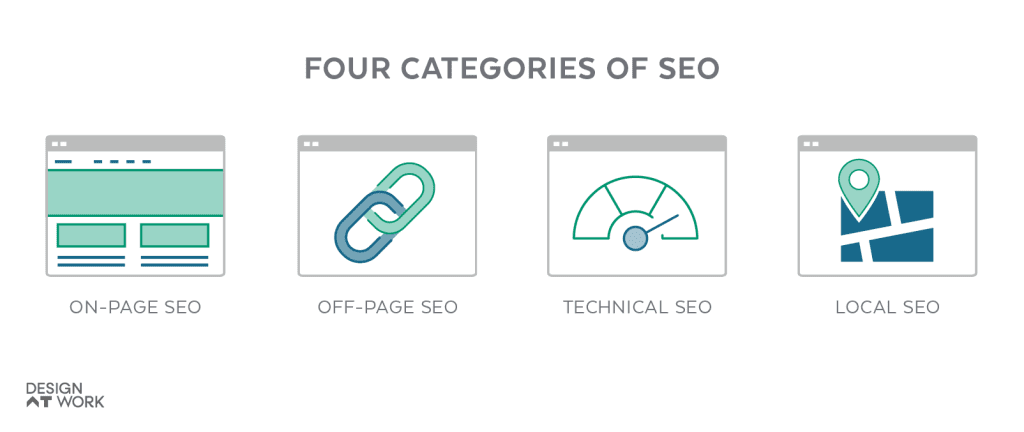Reaching the Right Audience with Search
Engine Optimization.

Content marketing has changed a lot in the last decade. Everyone now has a smartphone glued to their hands and can search anything in a matter of seconds. Now more than ever, branding and word choice matters — and SEO keyword choice is crucial. Search engine optimization (SEO) is the technical force behind your brand’s message that helps build your brand — and helps make sure your site is reaching the right people.
What is SEO?

It’s a little acronym that packs a lot of punch. SEO, short for search engine optimization, refers to a set of practices used to help improve your website’s visibility and ranking. SEO is broader umbrella term that can be broken down into three primary categories: on-page, off-page and technical. There are also several subcategories if you want to dig deep, but we’re going to pay special attention to local SEO.1 Learn a little more about each of these four main types below:

On-Page SEO.
Sometimes also called “on-site,” this type of SEO is just what it sounds like. It refers to the content on the webpages of your website, including things like body copy (like what you’re reading right now), keywords, metadata, images and alt text, headers and subheaders.
Off-Page SEO.
Also called “off-site,” this refers to SEO efforts that are not on your website’s pages. This includes backlinks and referral traffic, which also help your overall site authority. This, in turn, helps signify to Google and other search engines that your site is a high-quality resource.
Technical SEO.
This refers to elements that improve your website’s technical performance, including page loading times, crawl error codes or indexing issues, schema and original vs. duplicate content. Each of these are evaluated by search engines to further assess yoursite’s quality.
Local SEO.
This type refers to location-specific SEO that focuses on city, state and regional results. While this one isn’t usually considered one of the main three SEO types, we find this to be an important part of building up a business’ presence in their area. For example, have you ever searched for “restaurants near me?” That’s an example of results served up through local SEO. Optimizing your company’s Google Business Profile page can help show up in these types of searches.
How Does it Work and Why is
it Important?

Unlike paid digital advertising, SEO helps drive high quality organic traffic to your website. When a user searches for a specific term on Google — let’s say they’re looking for “website design services in Houston” — SEO helps determine how far up or down your website shows up in the results. In the simplest of terms, the higher up your site ranks, the more likely your customer is to visit it. So, what does this look like in practice? Let’s take a look at an example.
SEO in the Wild.
Let’s say there’s an outdoor sporting goods sells fishing poles but always refers to them as “rods” and doesn’t include the phrase “fishing pole” anywhere on the site. While they may show up on results for “fishing rods,” they could be losing out on thousands of searches for “fishing poles” a month. Over time, that can add up to quite a bit of missed profit.
However, it’s important to note that specific keywords are just one piece of the overall SEO puzzle. SEO practices are multifaceted and several elements — ranking, site authority, original content, quality resources and keywords — come into play. Optimizing your site is an ongoing process as your site evolves, and it requires ongoing maintenance.
How Can a Marketing Agency Help?
Feeling like there isn’t possibly enough time to do this on your own? Don’t worry — an outsourced marketing firm can help.
To increase your website’s traffic, marketing companies and their copywriters perform SEO research. The process includes researching competitor’s sites, pulling data on how people are searching for services, products or solutions like the ones your business offers, and identifying keywords and topic clusters to help organize the content on your site. Copywriters will also work closely with designers and web developers to ensure that your site’s backend — including meta and microdata — is set up to help optimize SEO efforts and help your site appear higher on the list of search engine results.
All in all, SEO is a critical aspect of content marketing that should be employed across your website, to ensure that your brand is front-and-center in the minds of your prospective customers. If you’re ready to get some SEO help, let us know. As a full-service marketing agency, Design At Work has the tools, team and technical know-how to make sure your site is putting its best foot forward.
Marketing Emails You’ll Actually Want To Read.
Get marketing tips and news sent to your inbox.


